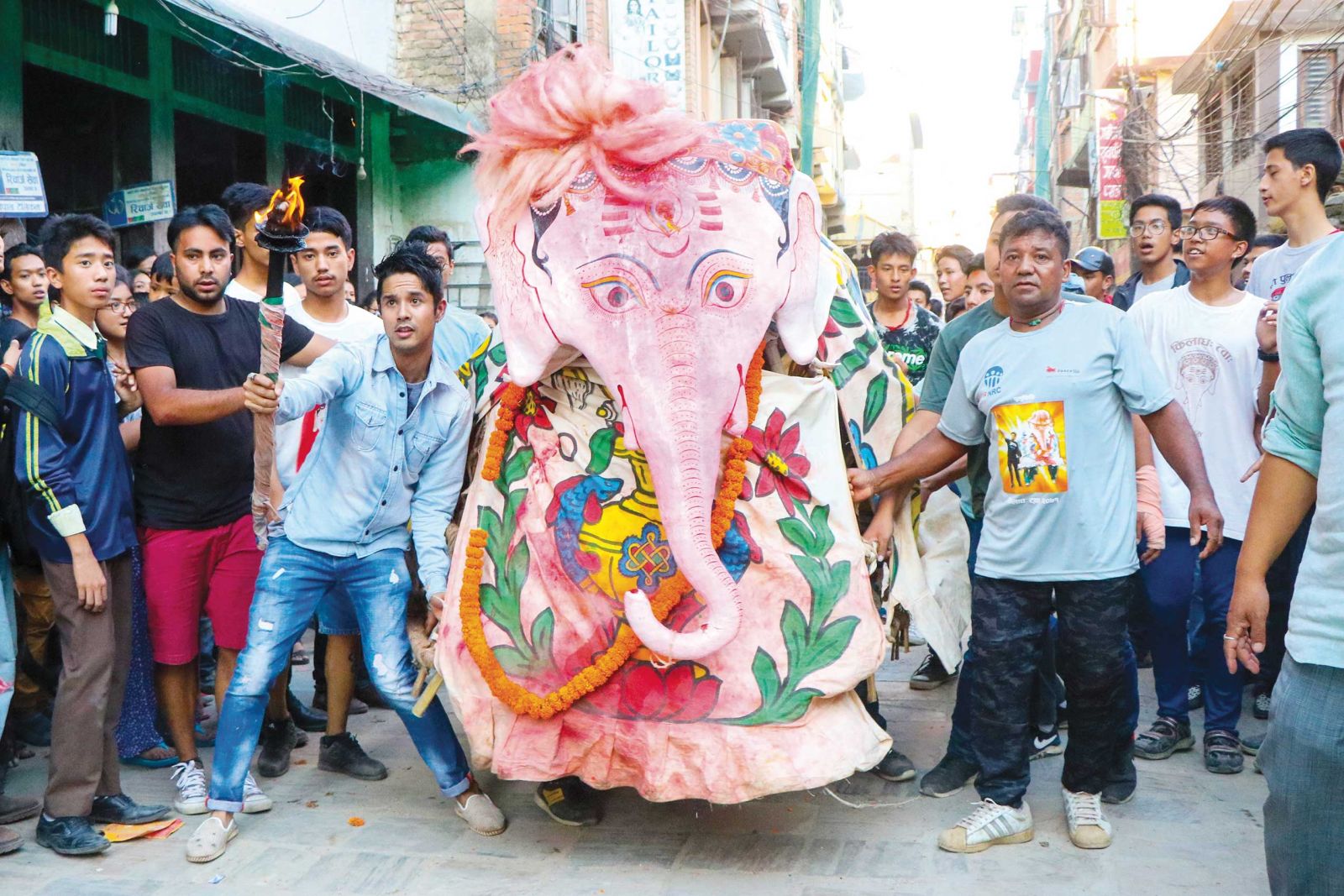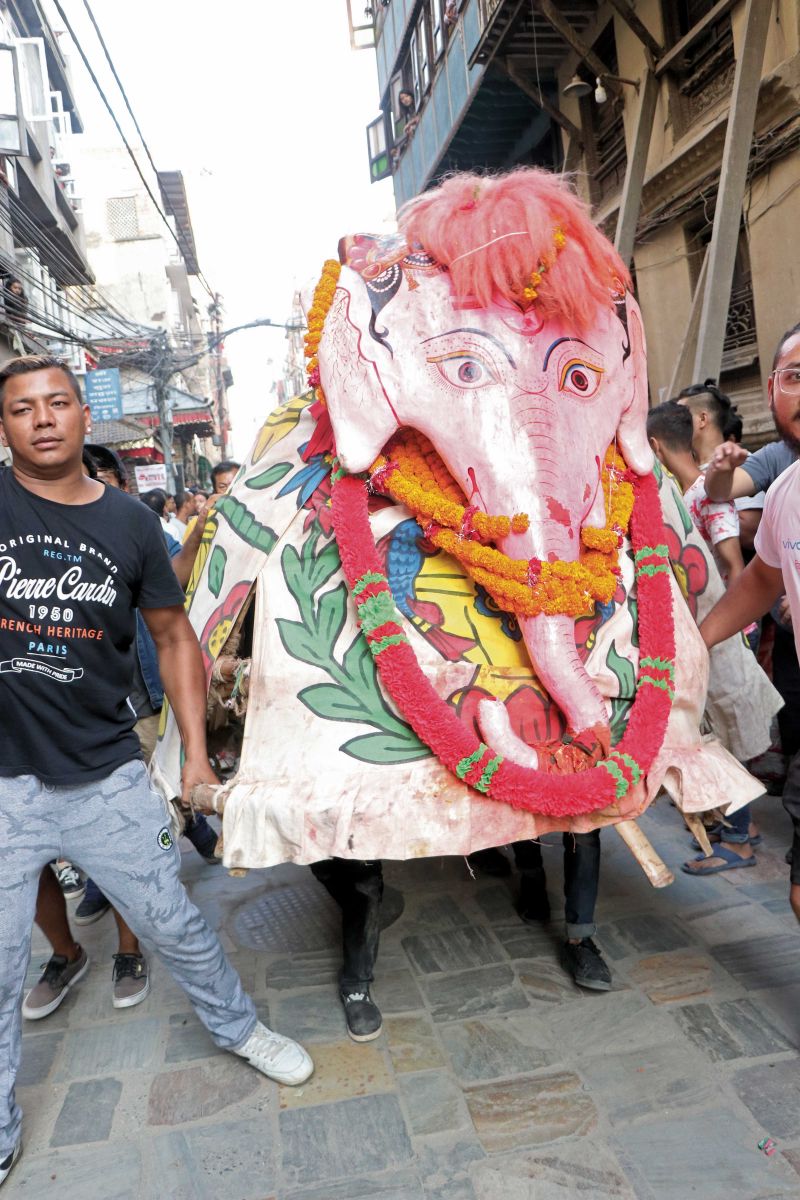
Indra Jatra is a revered festival with processions of living gods and goddesses, the dance of the demon, Lakhe, and several other masked performers who converge on the main Durbar Square. The eight-day festival also includes a procession of DÄgin. But none of them is as fascinating as the procession of Pulu Kisi, the white elephant in search of his master, Indra, king of heaven and the god of rain.
Armed with umbrellas and braced for possible heavy showers, hundreds of locals and tourists formed a human sea in the Basantapur Durbar Square area. I had a camera around my neck and regretted not finding a vantage point early in the day. In the midst of high security, the President, government officials and consular representatives had gathered at Gaddhi Baithak in front of Durbar Square to experience Indra Jatra. There was a sudden burst of clapping and cheering as the onlookers were making way for something. I had no idea what was coming and it added to the thrill. And finally, there it was, an elephantine figure with curving movements emerging from the crowd and descending upon the square accompanied by a torchbearer and musicians. It was Pulu Kisi, the white elephant.

Every year, local residents of Kilagal in Kathmandu celebrate the Pulu Kisi procession and dance with great euphoria and enthusiasm. Legend has it that the white elephant is none other than Airavata, who carries the Hindu god Indra. Indra is known by many names, one of them being Devraj, meaning king among gods; but while celebrating this auspicious festival, we learn how he was held as a captive in a small village in Kathmandu for stealing a flower.
It is believed that a long time ago, the God Indra descended to earth disguised as a human. He wanted to take the parijaat flower (night jasmine) for his mother back in heaven. Parijaat was a flower so precious it couldn't be found anywhere else but Kathmandu. He found the flower in a garden in Kilagal, then a small village surrounded by jungle, and plucked it. Unable to recognize Indra in his human form, the gardener caught him red handed, tied him up with a rope and took him as a prisoner. Airavata, the white elephant, came to find him and searched for his master everywhere.

When Indra did not return for a long time, his mother, the goddess DÄgin, came looking for him. Finding Indra a prisoner, she explained who he truly was to the locals, and he finally revealed himself to all of them. In return for his release, Indra promised to help the farmers by bringing clouds to the area and giving rainfall for cultivating crops. But the locals demanded that Indra also take the departed souls of the Newari community with him to heaven. Indra had no option but to oblige to the demands of the farmers. The departed souls followed Indra and his mother to Indra Daha (pond), currently in Thankot, and plunged into the water with them, reaching heaven. This episode is commemorated over eight days and there is a colorful reenactment through the Pulu Kisi and DÄgin processions. Some in the community still go to the Indra Daha to take a bath on the first day of Indra Jatra to mark the occasion.
According to Chandra Man Maharjan, the patron of the ancient procession, the festival is carried out by the guthi, (religious and cultural council or institution). There are dedicated guthi members, artists and musicians for the Indra Jatra festival and the Kilagha Twaa-Khala Guthi in the Kilagal area is the one that carries out the Pulu Kisi procession. There are 160 of them in the guthi and every year, eight members are given the responsibility to create, maintain and exhibit Pulu Kisi.

Pulu Kisi, the white elephant, is then re-created by the members of the guthi using various materials like bamboo, clay, clothes etc. The main structure is a bamboo frame, with the bamboo poles put together and laced with strong rope to secure them firmly and then shaped. All the joints are tied with ropes to create the structure, which is then covered by a white cloth. The cloth is painted using different colors. One can see flowers, bell and the copper utensil kalash painted on the costume made out of the cloth.
The mask is the most important part and also the heaviest. It is made out of mud, egg yolk and Nepali paper and then painted by an artist. The hair from the yak's tail is used as the hair of the elephant. The third eye on the elephant's face signifies that it can eat anything.

"Our ancestors were very strong; two of them could carry this entire structure. Now, a minimum of four individuals are required. They have to run through the crowd, perform dances exactly as the Airavaat did so it's a tough job, "says Chandra Man Maharjan.
He also explains how the costume gets torn and dirty constantly, and can also catch fire. It's the structure, however, that has gone through a constant evolution. "Since the elephant structure required constant repairs, ten years back a metallic frame was created to make it more durable but moving it around became an almost impossible task. Later, they made it using the light nigalo (Himalayan bamboo) but it couldn't hold the mask and the dancers fell during the performance, so they had to go back to using the original bamboo."
Two individuals are required just to carry the mask. There are usually two performers inside the structure to coordinate the playful, flowing movements of the elephant. A person leading the procession holds a torch; there are musicians who accompany the elephant playing instruments like the local drum dhime with the metallic face of an elephant carved into it, bhusya (hand cymbals) and bells. They have to work in shifts as they need to perform throughout the whole day of the eight days of the procession. It is paraded in places like in Sanepa, Gongabu, Samakhusi, Lainchaur, Lazimpat and Chauni.
A procession of the Goddess Dagini makes its way through the streets of the town from Maru Square to the Durbar Square while onlookers and musicians follow the route. It re-enacts Indra’s mother's search of her son. Another festival that coincides with Indra Jatra is the Kumari Jatra, a festival where the living goddess Kumari is pulled along in a chariot down the festive route so that her feet won't touch the ground. The Kumari's chariot is followed by two other smaller chariots with representations of the deities Ganesh and Bhairava on them. Masks of the god Bhairava are displayed at various places in Kathmandu during the festival, the prevalent one being the Sweta Bhairava (White Bhairab) at the Basantapur Durbar Square.

Maharjan believes that although the two festivals happen on the same day, Indra Jatra has celebrated for much longer. "The two festivals happen together, so many believe it is the same but Indra Jatra probably started hundreds of years before. Kumari Jatra probably began during the reign of Jaya Prakash Malla."The military parade is another attraction of the festival and is attended by many, including government officials and dignitaries.
Indra Jatra starts with the erection of the linga, a ten meter long flag pole with an outstretched banner of Indra, and ends when it's lowered. Images of Indra with his outstretched hands bound with rope are also exhibited on a tall platform at Maru near Durbar Square and at Indra Chowk, Kathmandu. When night falls, the families of the recently deceased come together and offer butter lamps to their loved ones.
"People used to fear the elephant in the past. Women weren't allowed to touch it but the tradition has changed in recent times. Everyone can enjoy it these days"

Pulu Kisi isn't the only revered elephant in Kilagal. There are two other mythological creatures. "The red elephant, which has a temple dedicated to Lord Ganesh, and the black elephant, which is a fabled invisible beast only seen by animals like cows, are two other such entities."
Historically, festivals and processions have long been part of the Nepali culture, often held to celebrate special events in time or to retell popular mythological stories. But they are mainly public displays of communal solidarity. As a valuable part of the country’s intangible culture, they should not be taken for granted; everyone is needed to safeguard them and bring them forward into the future, ensuing that these stories and rituals are never lost.









